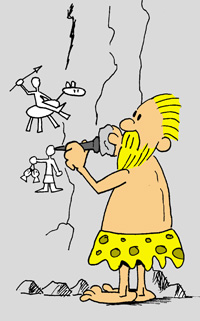|
A Brief Cartooning HistoryCartooning has a long, noble history. Although really becoming popular in the 20th Century along with the flourish of the film and newspaper industries, this important art form has been around for many thousands of years.
In later centuries, other societies, such as the Mayans and the Egyptians, carved intricate cartoons into solid rock. In fact, the languages of these two peoples were represented by figures of animals and people carved into their tombs and temples. As technology improved, so did the medium that was used. In the middle ages, monks painted very bright, intricate pictures to illustrate early books, such as the Bible. Cartoons were also used by painters of frescos and sculptors during the 15th and 16th centuries. The artists would sketch their ideas and designs on paper first; sometimes these drawings would be the same size as the finished project, and could therefore be very large. Through the 17th, 18th and 19th centuries, this art form became an important part of the printed world, being used to illustrate stories in books, magazines, and newspapers. Today, cartoons are everywhere. In addition to books and newspapers, cartoons can be found on bill boards, posters, television and movies. You’ll have a hard time spending a single day without seeing a cartoon somewhere, whether it be on a TV commercial, a magazine, or even an ad in your mailbox. This is great news for us cartoonists. Because of this, a cartoonist can get a job in almost any field!
Click here to return to the Cartooning Definition page
|





 Our human ancestors all over the world drew on caves and rocks. Using paint and charcoal, cave artists drew what was important to them. They produced pictures of animals, hunting scenes, people dancing, and performing rituals. Ranging from simple to extremely intricate, cave painting was a way for early people to leave a record of their daily lives.
Our human ancestors all over the world drew on caves and rocks. Using paint and charcoal, cave artists drew what was important to them. They produced pictures of animals, hunting scenes, people dancing, and performing rituals. Ranging from simple to extremely intricate, cave painting was a way for early people to leave a record of their daily lives.
